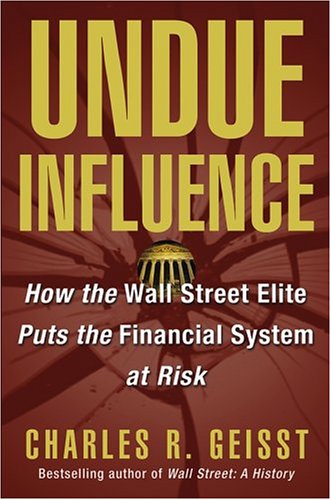
Undue Influence
How the Wall Street Elite Puts the Financial System at Risk
کتاب های مرتبط
- اطلاعات
- نقد و بررسی
- دیدگاه کاربران
نقد و بررسی

November 15, 2004
The Glass-Steagall Act, separating commercial banks from investment banks, was passed in 1933 to prevent banks from risking depositors' funds on the still-shaky stock market. It was repealed in 1999, when gambling other people's money on the stock market was considered the height of financial probity. In this engaging history of Glass-Steagall, Geisst (Wall Street: A History)
surveys the 70 years leading to this ideological sea change, as the widespread Depression-era populist suspicion of Wall Street subsided, to be replaced with the pro-business dogma of the Reagan era and the New Economy bubble. Formal repeal, Geisst shows, was preceded by decades during which big commercial banks, hungry for a slice of the lucrative investment banking business, increasingly flouted Glass-Steagall restrictions with the connivance of ideologically sympathetic Federal Reserve regulators. The vast sums banks have spent on lobbying and campaign contributions, and the cushy Wall Street jobs awaiting government officials who switch sides, make Geisst wonder whether "the gamekeepers and the poachers had all joined the same club." Geisst provides a lucid guide to the financial issues involved and a colorful account of decades-long political debates and legislative wranglings, while raising troubling questions about the direction of public policy.

February 1, 2005
In the first half of his somewhat mistitled book, Geisst (finance, Manhattan Coll.; Wheels of Fortune ) chronicles the implementation of U.S. banking and investment regulation leading to the passage of the Securities Acts of 1933 and 1934 and the Glass-Steagall Act. He does a fine job of describing the evolution of regulatory legislation, then spends much of the rest of the book detailing the efforts of bankers acting in concert with various government officials from the 1950s onward to roll back such legislation, culminating in the passage of the 1999 Financial Services Modernization Act. Only in the last dozen or so pages does Geisst cover the debacles of the savings and loan crisis, WorldCom, Enron, and the 2001 stock market collapse, thus supporting his case that the dismantling of the 1930s regulations was overdone. Though not the financial tell-all book that its title implies, this legislative history of 20th-century U.S. financial regulation belongs in most academic and larger public libraries.--Lawrence R. Maxted, Gannon Univ., Erie, PA
Copyright 2005 Library Journal, LLC Used with permission.

























دیدگاه کاربران